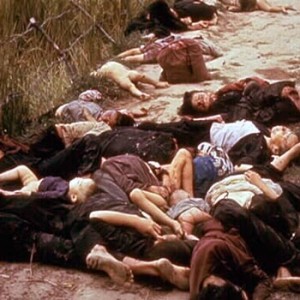On March 16th 1968, the American combat soldiers of Charlie Company, First Battalion, 20th Infantry Division swept into the South Vietnamese village of My Lai and massacred 504 unarmed, unresisting women, children and elderly men. Babies were shot at point-blank range. Women and girls gang-raped. Boys sodomised. Over 100 civilians were herded into an irrigation ditch and mowed down with automatic weapons. Villagers attempting to surrender were tortured, clubbed with rifle butts and stabbed with bayonets. Some were mutilated with the death-signature “C Company” carved into the chest. Four hours later, the entire village had been burned to the ground and the corpses of its former residents – ostensibly the very people America was meant to be ‘defending’ – were strewn everywhere. This was no ordinary ‘search and destroy’ mission. This was a cold-blooded murder spree, later described by a member of Charlie Company as “a Nazi-like thing.” But while Nazi war criminals were tried and executed for similar crimes, the American army and government endeavoured to cover up what came to be known as the My Lai Massacre – the most brutal and notorious U.S. military atrocity of the Vietnam War.
So what caused these typical American boys to go so utterly berserk? Charlie Company had only been in Vietnam for three months, but the unit’s arrival coincided with the beginning of the Viet Cong’s unexpected Tet Offensive. In response, the US Army initiated a programme of destroying the food and water supplies of villages suspected of harbouring or sympathising with the communists. On March 15th, Charlie Company received its orders to clear out possible V.C. sympathisers in My Lai. Just weeks earlier, these very soldiers had visited the very same village, played with the children and given them cake. But since then the unit had come under relentless guerrilla attacks, suffering five deaths and 23 injuries from landmines, booby-traps and snipers. For the besieged soldiers of Charlie Company, the line between enemy and civilian had become dangerously blurred. On the eve of the attack, Captain Ernest Medina told his soldiers: “They’re all V.C. – now go and get them.” And that’s just what they did.
In the wake of the massacre, the entire chain of command complied in a systematic cover-up. Misled by army misinformation and publicity reports, American news agencies even reported an “impressive victory” by American soldiers at the “battle” of My Lai, while General Westmoreland congratulated Charlie Company on an “outstanding job”. The American public remained unaware of the horrific truth of My Lai until – a year-and-a-half later – reporter Seymour Hersh broke the story following conversations with Ron Ridenhour, a former member of Charlie Company who had sent letters to various government officials urging them to investigate “something rather dark and bloody” that had happened in Vietnam. As Hersh’s story and the accompanying photos of the atrocities were splashed across the pages of national newspapers and television screens, Americans for the first time were directly confronted with the brutality of their own soldiers, contradicting not just their propagandised notion of the war in Vietnam, but also the longstanding American tradition of depicting the enemy – whether Indians, Nazis, Japanese, or Vietnamese – as the exclusive perpetrators of monstrous atrocities. Notwithstanding the Indian Wars (which obviously “didn’t count”), Americans just weren’t supposed to do such things.
Spurred by the controversy, the Army ordered a full-scale investigation of the My Lai Massacre. Thirteen soldiers were indicted for war crimes, but only Second Lt. William Calley was convicted and sentenced to life imprisonment for murder (he would ultimately serve less than four years). The U.S. Government and Army had its scapegoat, and hoped to return to the more pressing business of its futile war in Vietnam. But the American public refused to let the matter die. As the nation struggled for a rationale, the concept of the exploited and psychologically scarred Vietnam veteran emerged – and the government was blamed for a war that corrupted its good ol’ American boys.
We shouldn’t forget who the real victims are here… those 504 innocent civilians of My Lai. And there can be no excuse for the collective insanity of an entire unit. But in its arrogant zeal to police the world and save us all from the Red Threat, the U.S. government undoubtedly engaged its own in an irresponsible war without any cultural understanding or proper respect for its “sub-human” enemy. And clearly not much has changed in the half-a-century since the My Lai Massacre, as evidenced by some one million civilian casualties in Iraq. This is the same imperialistic and willfully world-ignorant mindset that dropped peanut butter and Pop Tarts of all things to people accustomed to a Middle Eastern diet shortly after the U.S. attacked Afghanistan for supposedly sheltering Osama bin Laden. If that is the arrogance from the men at the top, how does that translate to the foot soldiers?



7 Responses to 16th March 1968 – the My Lai Massacre